Just a few photos from the nearby pond, mostly recent, without a lot of exposition to go along.
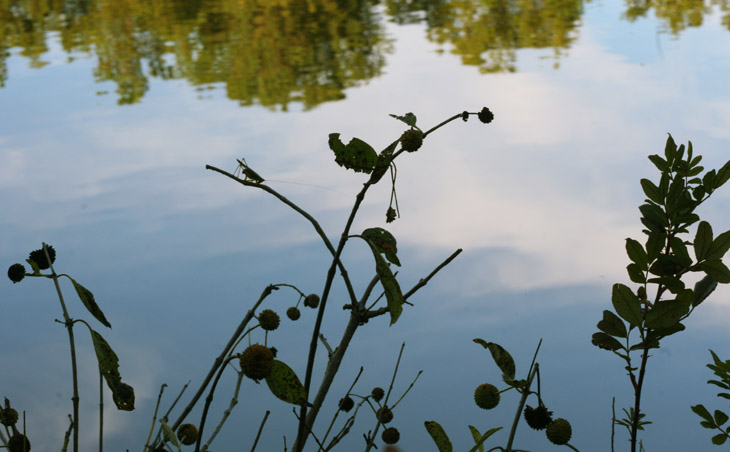
An unidentified orthopteran, what I suspect is a meadow katydid, poses atop a button bush that’s showing the impact of the lateness of the season and the sparse rain in the past. In the thin line of undergrowth bordering the pond right below it, I was spotting various mantids and had examined the upper branches carefully in the hopes of producing just this kind of photo, only with a mantis instead.
 In fact, this small section of bushes was home to several specimens of Carolina mantis (Stagmomantis carolina,) smaller than the Chinese mantis but native rather than introduced. Which of course raises the question of how we determine “introduced,” since the similarities between the two species are much greater than that between, say, a Carolina mantis and a shield bug, or really anything else. Chances are the species was also introduced to North America well in the past, before being taxonomically described in the 18th century as a “native” then. At some point I’ll look up the genetic comparison between them.
In fact, this small section of bushes was home to several specimens of Carolina mantis (Stagmomantis carolina,) smaller than the Chinese mantis but native rather than introduced. Which of course raises the question of how we determine “introduced,” since the similarities between the two species are much greater than that between, say, a Carolina mantis and a shield bug, or really anything else. Chances are the species was also introduced to North America well in the past, before being taxonomically described in the 18th century as a “native” then. At some point I’ll look up the genetic comparison between them.
Now that I’m finding more, I’ve been looking into them more closely, and apparently the males are the ones usually sporting the brown “urban camo” coloration while the females remain green – not a trait that holds true for the Chinese mantis, where either sex can be either color. And shortly I’ll be back with more about that species, because I just tumbled across another detail that I’m not going to go into here.
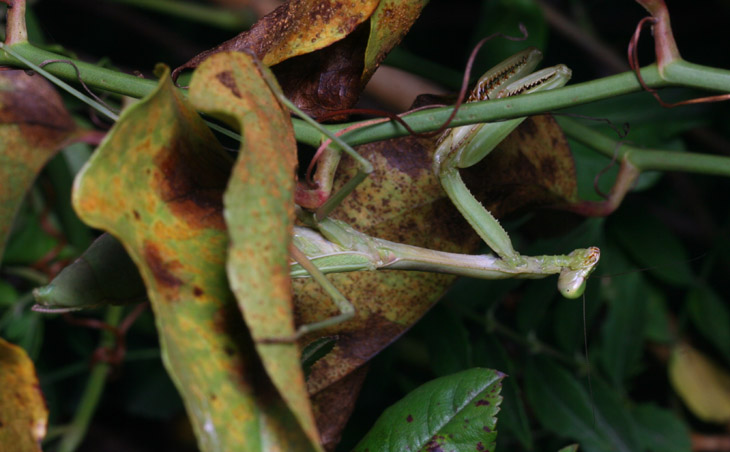
I get the impression that the Carolina mantis has a much shorter lifespan or season than the Chinese, because these definitely appeared much later in the year, and while most of the ones I’m finding are juvenile, I still spotted a pregnant one soon to produce an egg sac. Either than or it was an undersized Chinese. But you can see the swollen abdomen reappearing from behind the leaf to the left.
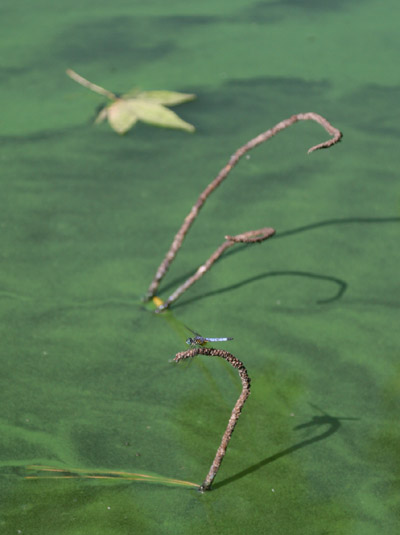 A month ago, when we’d been for a long period without rain, the water developed a notable patina of algae which would produce interesting patterns with the input of a breeze, and I took the opportunity to shoot some semi-abstracts when a blue dasher dragonfly (Pachydiplax longipennis) posed on a mostly-submerged pine branch. With two weeks of downpours introducing fresh water, the algae is mostly gone now and the pond level back where it belongs, even though many plants were hit too hard by the lack of rain to fully recover this year.
A month ago, when we’d been for a long period without rain, the water developed a notable patina of algae which would produce interesting patterns with the input of a breeze, and I took the opportunity to shoot some semi-abstracts when a blue dasher dragonfly (Pachydiplax longipennis) posed on a mostly-submerged pine branch. With two weeks of downpours introducing fresh water, the algae is mostly gone now and the pond level back where it belongs, even though many plants were hit too hard by the lack of rain to fully recover this year.
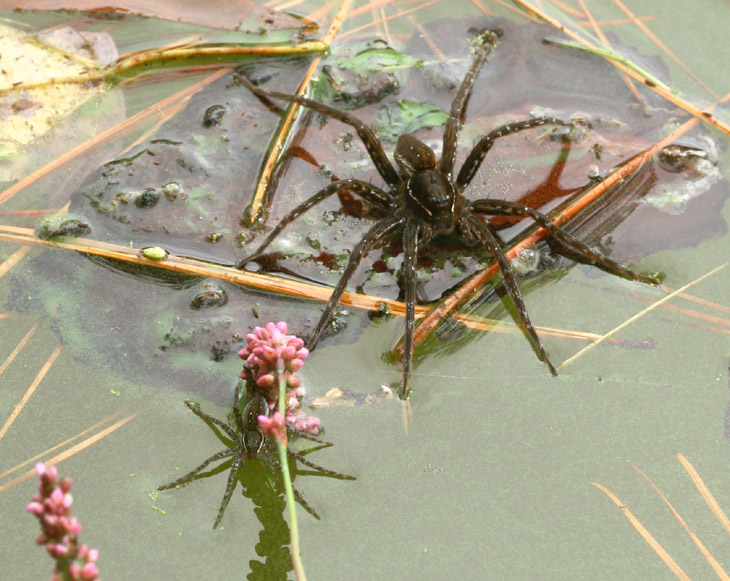
In a quieter portion of the pond, some of the algae was still vaguely visible while I watched a pair of six-spotted fishing spiders (Dolomedes triton) hanging out. This gives a good idea of the disparity of sizes in which they can be found, though this post gives a better one – the larger one here is about 20mm in body length, pushing 60mm in leg spread. I hadn’t even spotted the smaller one when I took this image, but it became a bit more apparent when its movement aroused the attention of the larger one, which gave brief chase across the water surface. Protecting its territory? Maybe, maybe not.
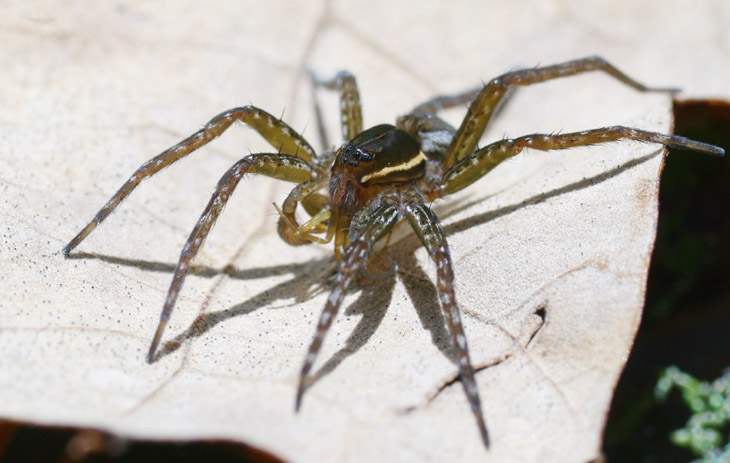
A few days later in the same location, I watched one which might have been the same smaller specimen, and on close examination found that it possessed a meal, certainly another spider. Same species, as in, cannibalism? Perhaps, I can’t be sure – I’ve watched fishing spiders snag one another before. One emergent trait of evolution is the tendency to favor one’s own genetic line, and this shows in a lot of species (including our own.) Among the spiders, it not only means any other species of spider is an acceptable food source, it might also mean that any spider not obviously a sibling is one too, and the disparity in size is a good indication of not being related. However, if food is scarce enough, even a sibling might be fair game – one example of the genetic line surviving is all that’s ‘necessary,’ and better than both dying out because neither can find acceptable food.
And just a quick one to prove that, while I’m definitely paying attention to the arthropods, I won’t pass up the opportunity to shoot something else.
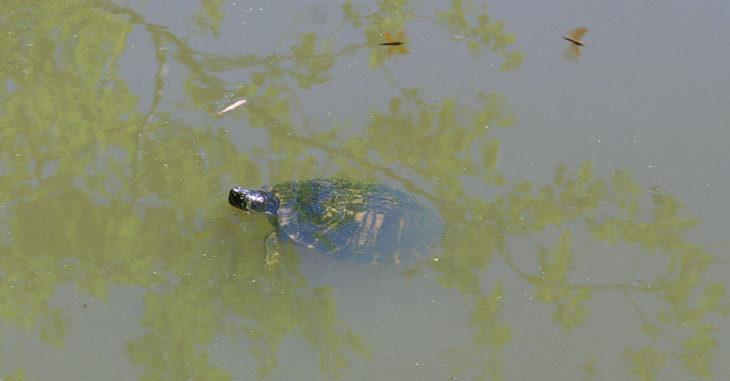
This turtle, probably a yellow-bellied pond slider (Trachemys scripta scripta,) was being atypically bold when I approached the water’s edge to look for the fishing spiders again. Likely because of the large number of people who let their dogs leap into the water here, the turtles tend to be very shy and disappear quickly on approach, but this one kept a casual eye on me even when I came within four meters, so I did a few quick shots – I liked this one for the reflection of the branches and the inclusion of two rust-colored dragonflies. I know you won’t believe me when I tell you they were not the primary photo subjects, but I only have myself to blame for that.
Photos from today, and yet another mantis update, will be along shortly.




















































